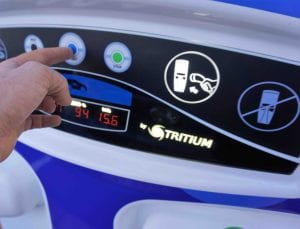
Yesterday, we discussed a new project in Germany, in which electric vehicles provide ancillary services to stabilize the grid while these cars are charging. Today, we focus on some of the findings.
First, the good news: the project enables EV owners to earn up to 500 euros a year, depending on how much battery capacity is made available. The downside is that the battery is worn down in the process – quite considerably.
“Providing grid services for the secondary reserve [which kicks in after 30 seconds to stabilize the grid frequency at 50 hertz, ed.] is basically the same burden on the battery as driving the car is,” explains Detlef Beister of inverter manufacturer SMA. However, the services provided by the EV can be defined so that they remain reasonable.
The provision of primary ancillary services is different. Here, large amounts of energy are not put into or taken out of the battery for extended periods. Instead, small and large amounts may move, depending on need, but only briefly. As a result, the battery’s rated output is more crucial here than its total storage capacity. “The load on the battery for the provision of primary services is below 10 percent,” Beister estimates.
If the car is also charged from a solar array, connections to the market for ancillary services become really complicated. “You additionally have to take into account whether it is better at a given moment to provide the service to the grid or consume the solar electricity within the home instead of paying the retail rate and consuming from the grid,” explains Gero Lücking of German green power provider Lichtblick.
The technician who optimizes the overall system for the owner of the array and electric vehicle then have to decide in which order what will be done: charge the array’s battery first and then the electric car and then fell to the grid, or charge storage partly and then start taking part in the ancillary services market?
With German retail rates now around 25 cents per kilowatt-hour, “the focus will first be on directly consuming solar electricity, including charging the car, to offset purchases of grid power. Only then does it make sense to think about business models for EVs providing ancillary services,” Lücking says.
“Models that are easier than participation in the secondary services market will probably be created for the integration of vehicle batteries, because once you have control of that, you can use all other optimization models.”
Unfortunately, German carmakers are not yet on board. No German electric vehicle currently supports bidirectional charging. But there are such cars from Japan. For instance, Nissan integrated bidirectional charging in the first generation of its electric cars. Toyota and Mitsubishi now also offer this function. The Germans have some catching up to do.
Source: Renewables International. Reproduced with permission.










